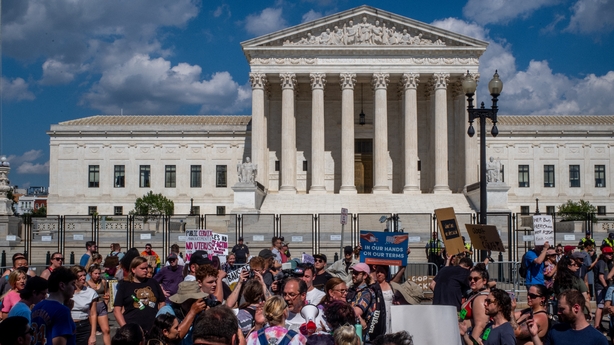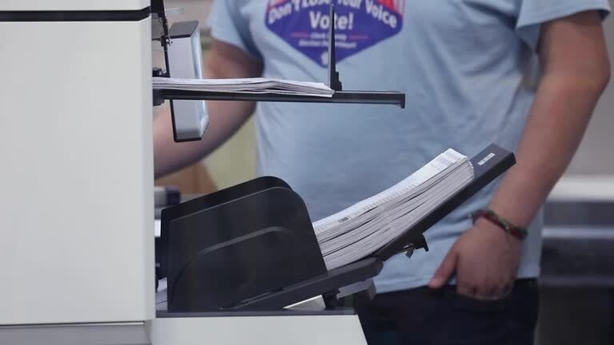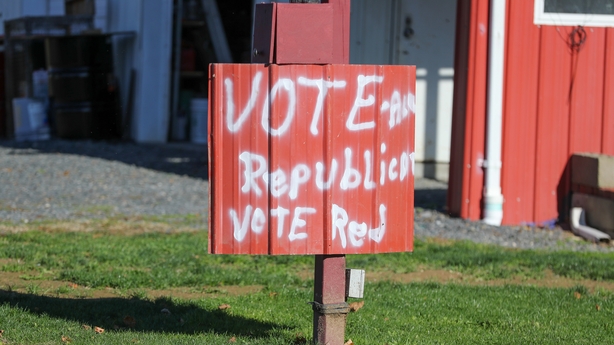Joe Biden and the Democrats did much better than expected. Donald Trump and the Republicans did much worse than expected. But what else happened in the mid-term elections?
1. Abortion was a big deal
The Supreme court ruling in the Dobbs decision ended a federal right to abortion, which applied to all 50 states, returning the decision to each state to regulate abortion under state law. This was the position prior to the Roe v Wade ruling in 1973.
In these midterm elections abortion referendums were held in five states. In Michigan, California and Vermont, voters approved placing a right to abortion into the constitution of those states. In Kentucky and Montana, voters rejected propositions to further restrict abortion in those states.
In Kansas, a state referendum to restrict abortion was rejected by voters in a conservative state. The issue drove a surge in women registering as voters. A similar pattern was observed in other key battleground states.
These results correspond with polling, which finds that most Americans are in favor of the availability of legal abortion by around two to one.

But the Dobbs ruling, which overturned the abortion practice established by the Roe v Wade ruling of half a century earlier, was also a big mobilising factor for the Democratic party base. It may well have been the issue that carried Democrat candidate John Fetterman into the US Senate over his Republican rival Dr Mehmet Oz.
Exit polls in Pennsylvania showed that abortion was the voters’ number one concern, cited by 37% of those surveyed, compared with 28% who picked inflation and 11% crime. The issue also appears to have had a mobilising effect on young voters, who are notorious for low turnout. But long lines at polling stations in college towns across the US, but especially in State College Pennsylvania and Ann Arbor Michigan suggest abortion may have been a decisive factor in this demographic. (These were the only states where abortion trumped inflation as the voters’ main concern, suggesting campaigning was a key influencing factor).
Abortion rights activists and the Democratic Party also spent big in key constituencies. Ad Impact figures say the Democrats spent $27m on TV ads, reflecting their position on abortion in Pennsylvania. The Republicans in that state spent just $65,000, according to the same source. In Michigan, Democrats spent $38m on abortion ads, against a Republican spend of $7.5m. The Democrats won the governor’s race and the state house for the first time in 40 years.
In the two super-tight (and super-slow) senate races in the southwest, abortion ads also followed this pattern: in Arizona Democrats spent $30.7m on abortion ads, Republicans just $3.3m, in Nevada, Democrats spent $36m, Republicans $1.4m.
In New Hampshire, Democrat Senator Maggie Hassan was considered the party’s most vulnerable senate seat, but she retained it. She was an early adopter of the abortion rights message, running campaign ads on the issue for months.
2. A new record for women governors
OK, 12 out of 50 is not exactly overwhelming, but it is a new record for the number of female governors. The previous high of nine was set in 2004 (and is still current). But it’s still important progress for women in politics in the US.
Governors are the key executive layer in the US system – the job is probably the best preparation for the job of president of the United States, and more women governors means the pool of potential female presidential candidates increases as well.
And the parties are nominating more women – between them they put forward 25 female candidates (16 Democrats, nine republicans) for the 36 Governors posts up for election.

In Arizona, Iowa, Michigan and Alabama, voters could only choose a woman as their governor, as both parties nominated women candidates. Notable winners were Kathy Hochul in New York, the first woman to be elected to the post, former Trump administration spokesperson Sarah Huckabee Sanders, who followed her father into the governor’s mansion in Arkansas, and Democrat Maura Healy in Massachusetts, the first openly lesbian governor.
In Michigan, incumbent Gretchen Whitmer beat Republican challenger Tudor Dixon, a talk show host who was supported by Donald Trump.
She was also reported to be in in favor of a total ban on abortion, including in cases of rape and incest. Whitmer was the leading figure in the Democrats’ surge in Michigan, where the party also captured both houses of the state assembly. The performance has led to her being spoken of by some as a potential presidential or vice-presidential candidate. (She was the subject of a kidnapping plot by a militia group in 2020 – five men have been convicted after trial and are awaiting sentence).
3. A Republican challenger emerges
Ron DeSantis had a huge win in the governor’s race in Florida, beating his democratic challenger by nearly 20 percentage points. He also won the votes of a reported 53% of women voters.
He had signed into law a 15-week limit on abortions. Marjorie Dannenfelser, President of Susan B Anthony Pro-Life America, told CBS news that Republican pro-life candidates “win in competitive races if they define their opponents as abortion extremists … and contrast that with a clearly defined pro-life position centered around consensus such as pain-capable or heartbeat limits. This must be the key takeaway for the GOP as we head into the 2024 presidential cycle, especially those eyeing a run for the White House”.
She criticised Dr Oz and the Pennsylvania Republicans for not spending or campaigning on the issue, and also criticised Republican Senate leader Mitch McConnell for not being active on the issue in the referendum in his native Kentuckey.

The abortion issue may highlight DeSantis’s data driven, details-oriented approach to politics, which has seen him advance a conservative agenda by knowing how far the voters in key constituencies are prepared to go.
The re-elected governor was credited (or accused) of taking a very hands-on approach to redrawing the constituency map of the state (redistricting as it’s known here – which happens every ten years after a census shows where people are living: it’s a highly political and contentious process).
De Dantis pushed hard on the redrawing and picked up four extra seats in the house of representatives. Republicans now have 20 of the state’s 28 seats in the House. Marco Rubio won the Senate seat election by a wide margin. And DeSantis ran away with the governor race. Florida used to be a toss-up state (think back to the 2000 Presidential race). It is now overwhelmingly Republican – and that has given DeSantis his powerbase in the Republican party for a run at the 2024 Presidential election nomination.
Even before the election, Donald Trump (a constituent of DeSantis’ in Mar-a-Lago), started badmouthing the governor – whom he nicknamed “Ron de Sanctimonious”.
Trump tends to denigrate serious opponents with nicknames. But it didn’t work with “Sleepy Joe”, and may not work with “DeSanctimonious” either.
4. Trumps nomination for the Republicans in 2024 is not a sure thing
The charge that Donald Trump is a serial loser was made most forcefully by the Wall Street Journal in an editorial on Friday. The Rupert Murdoch owned newspaper is the number one newspaper in America by print circulation, and number two (to USA Today) by total readers. So, it’s important by any measure. But it’s particularly influential in conservative circles – particularly the wealthy ones who fund Republican candidates.
The Journal was devastating in the granular detail that supported its main claim – that Trump lost elections in 2018, 2020, 2021 and 2022. The only election he won was the 2016 presidential. In every other case he was a negative factor for the Republican party, according to the paper’s editorial board.

Murdoch’s other big daily paper asset in the US, the New York Daily Post, had an egg-shaped Trump called Humpty-Trumpty, sitting on a wall … and suffering a big fall from the election results. Murdoch’s Fox News Channel, the key conservative broadcast channel, has been carrying debates in which the merits and demerits of Trump are vigorously debated.
They are even more vigorously debated within Republican circles – and sometimes without. A stream of Republican party operatives and consultants have been surfacing on the electronic media to denounce Trump as a loser and a negative drag on the party.
The emergence of Ron DeSantis as a credible challenger to Trump – who can bring the Republican wing with him without alienating the centrist heart of the party – is a strong proposition for those looking to coalesce around a candidate who is not Donald Trump.
Trump has threatened to unload damaging revelations about DeSantis – observers say he always moves to negate his main threat first, then work down the field standing against him. But he will be hobbled with the growing list of legal actions against him, while DeSantis can look businesslike (if not statesmanlike) by getting on with the business of being the political chief executive of his state – which gives him both credible standing in politics by virtue of holding an actual executive job, and giving him a platform to intervene in national debates (like the culture wars issue with Disney Corp, a major employer and taxpayer in the state).
5. Election deniers did badly – but not everywhere
The two candidates who were present at the 6 January protest that turned into the assault on the US Congress who were running for elected state offices that would give them influence over the running of the 2024 election both lost.
Doug Mastriano, who ran for Governor in Pennsylvania, and Mark Fincham, who ran for Secretary of State of Arizona, were both defeated – heavily in the case of Mastriano (who ran a poor campaign in which he refused all media engagement and did not debate his opponent), and not so heavily in the case of Fincham.

He was filmed outside the Capitol building on 6 January, distinctive in a black cowboy hat. A former policeman he was associated with the Oath Keepers, the paramilitary-type group that had a tactical unit involved in breaching the Capitol building. A number of Oath Keepers are on trial in Washington DC at the moment for seditious conspiracy. (The Oath Keepers leader Stewart Rhodes was a regular guest on the Alex Jones of Infowars website).
But they were just two of more than 300 candidates – a majority – of Republicans standing for office in these elections at local, state and federal levels who had either criticised or raised questions about the process and outcome of the 2020 presidential election. Many of them have claimed Donald Trump won the 2020 election.
The most important concentration of so called “election deniers” was in the seven states that “flipped” for Joe Biden in 2020. In Pennsylvania, while Mastriano lost, seven of eight Republicans running for the House of Representatives won their contests.
In Georgia Seven of the eight election deniers for House of Representatives won their seats. The Senate candidate Herschel Walker, hand-picked by Donald Trump, was neck-and-neck with the Democrat incumbent, and goes forward to a runoff election on 6 December.
The runoff announcement was made by Brad Raffensperger, the Secretary of State for Georgia. He testified at the January 6th Committee, where he spoke of President Trump’s efforts to persuade him not to certify the result of the presidential election. The Governor of Georgia, Brian Kemp, refused to bow to Donald Trump’s pressure to “find” nearly 12,000 votes to declare Trump the winner of the state. He won his race to retain the Governorship by a strong margin.
In Nevada election deniers lost the races for House of Representatives, Secretary of State and US Senator (very narrowly in the case of Senate candidate Adam Laxalt).
In Michigan, three of eight deniers on the ballot were elected.
The US Republican Party is now at a fork in the road. It has to make a decision about which direction the Grand Old Party moves in next: the Steve Bannon formula of doubling down on doubling down; or the much more carefully calibrated Ron DeSantis formula. In other words, to Trump, or not to Trump – that is the question.
The arguments on the road to Milwaukee 2024 will be fascinating.
What we learned from the US mid-term elections
Source: Viral Trends Report


0 Comments